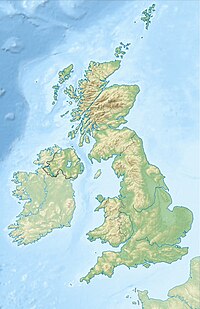Goldeneye Gas Platform
 From Wikipedia - Reading time: 3 min
From Wikipedia - Reading time: 3 min
Goldeneye Gas Platform was an unmanned and now demolished offshore gas production platform in North Sea block 14/29, in the South Halibut basin area of the outer Moray Firth, 105 km northeast of St Fergus Gas Plant in Scotland.
Field
[edit]The field was discovered in October 1996 with well 14/29a-3. The field extends into blocks 14/28b, 20/30b and 20/4b.[1] The reservoir is a lower cretaceous Captain sandstone with high rates of production, up to 2.8 million cubic metres (100 million cubic feet) per day at standard conditions per well and lies at a depth of 2,500 metres (8,300 ft).[1]
Infrastructure
[edit]The jacket was a four-legged piled structure weighing 3,500 tonnes, anchored by eight piles weighing 2,500 tonnes. The jacket supported the 1,000 tonnes topsides.[1] The topsides were designed by SLP Engineering Ltd. Production was from five wells with well fluids separated by a single vertical separator vessel. Separated liquids were re-injected into the export gas stream without further treatment. Facilities were provided for the installation of a future produced water coalescer and flash drum.[2] Gas and liquid were piped ashore to St Fergus under well pressure, via a 20 inch pipeline without using compressors, where it was processed. It operated in 120 metres (390 ft) of water.[3][4][5]
Production
[edit]Production started in 2004 and ceased in 2011. It had a potential use for carbon dioxide storage.[6] The topsides and jacket were removed in September 2021 and taken to Vats, Norway for dismantling and recycling.[7]
Like most North Sea fields operated by Shell, it is named after a bird - in this case Bucephala clangula, a small duck found in Scotland and elsewhere.
See also
[edit]- Operation Goldeneye - World War II operation involving Ian Fleming
References
[edit]- ^ a b c "Goldeneye gas platform". Retrieved 5 November 2022.
- ^ Process Flow Diagrams: Gas Production and Future Water Treatment
- ^ "Quadrant 14" (PDF). UKCS Quadrant Map. Department of Energy and Climate Change. Archived from the original (PDF) on 5 April 2013. Retrieved 5 June 2013.
- ^ "Goldeneye Gas Platform, United Kingdom". Industry Projects. offshore-technology.com. Retrieved 5 June 2013.
- ^ "Goldeneye takes flight" (PDF). Process Engineering. Retrieved 6 June 2013.
- ^ "Goldeneye". Subsea IQ. Rigzone. Retrieved 6 June 2013.
- ^ "Goldeneye platform removed in the UK North Sea". Retrieved 5 November 2022.
 KSF
KSF